Abstract
LVDC buildings use a low-voltage direct current (LVDC) distribution system for energy transmission and integrate photovoltaic (PV), battery energy storage (BES) and the utility grid as building energy resources. This technology can reduce energy loss in conversion to a certain extent and increase renewable energy compared with traditional AC distribution systems. Under the national goal of carbon peaking and carbon neutrality, LVDC buildings have been proven to be a new approach to energy conservation and emission reductions, and have been applied in engineering in China. However, the construction methods and integrated technologies of those projects are not clear, and technical barriers and policy constraints for the engineering application of LVDC buildings are not systematically discussed yet. This paper presents the latest study of LVDC building engineering applications the advantages and drawbacks of LVDC development in China. First, relevant policies and standards which support the development of LVDC building industries are summarized. More than 60 practical LVDC projects are investigated, and the application characteristics and the technology status of building types, and their capacity and design methods, etc., are analyzed. The attitudes of stakeholders toward LVDC buildings are surveyed to determine the policy direction according to the demands of this technology, with reference to building practitioners who intend to engage in LVDC projects.
1. Introduction
In response to carbon peaking and carbon neutrality goals, it is critical to create strategic guidelines for deepening the reform of energy infrastructure in China and set up a new power system [1]. To achieve the above strategic goal, state and local governments have issued multiple regulations to increase the proportion of renewable energy generation, further develop the photovoltaic (PV) industry, and strengthen user-side applications. However, the power system still faces challenges in the approach to addressing the rapid development and high-proportion access to distributed renewable energy. As a new type of building, low-voltage direct current (LVDC) buildings are based on a DC distribution system and integrate renewable energy generation and distributed energy storage [2,3]. Distributed energy generation, with solar PV and battery energy storage (BES) as the mainstays, has become a trend, while electric vehicles access the LVDC buildings as new energy consumers. As a result, a DC distribution system can reduce energy loss by lessening the conversions from DC to AC, thereby alleviating the pressure of renewable energy impacts to the utility grid [4,5]. Therefore, LVDC buildings can effectively improve system energy usage and control efficiency and provide more security and reliability for buildings’ microgrid energy consumption. The application of LVDC buildings can be used as a brand new appropriate technology to achieve the long-term strategic targets of buildings’ energy savings, emission reduction, and sustainable urban development, with a goal of net-zero energy consumption [6,7]. The main drivers for developing this technology are summarized as follows:
- the improving application of renewable energy increases the demand for energy flexibility;
- more and more building electrical appliances are driven by DC power; and
- the development of electronic technologies can solve most DC protection problems.
With the support of local governments in China, more LVDC building projects have gradually been constructed and operated recently, injecting a strong impetus for this emerging technology [8,9]. However, the construction methods and integrated technologies of those projects are not clear, and technical barriers and policy constraints for the engineering application of LVDC buildings have not yet been systematically discussed. Industrial development will be limited without the abovementioned knowledge. This paper intends to make an introduction to this engineering technology from multiple aspects, such as its application basis, development status, internal driving strength, and technical barriers in China. Section 2 summarizes relevant policies and standards which support the development of LVDC building industries. The investigation results we conducted for more than 60 LVDC projects and their application characteristics and technology status are analyzed in Section 3. Section 4 focuses on analyzing the engineering stakeholders’ concerns, summarizing the strengths and weaknesses of the technology during development, and more importantly, identifying the policies that will be necessary to guide this technology as it becomes more appealing to consumers. This paper not only makes a periodic summary of the application of LVDC building technology in China, but also investigates and analyzes the applicability of different technologies in this field. The conclusions can be referred to by building practitioners who intend to be engaged in LVDC projects.
2. Policies and Standards
Policies are essential for the research and development of engineering practices of LVDC buildings. This section reviews the favorable policies issued by the Chinese government that spur substantial progress in the application of LVDC building technology as well as the opportunities for development resulting from these policies. Establishing standards is the first step in a new technology’s efforts toward project implementation. To investors’ delight, a basic standard framework has been equipped for this technology in its fledgling stage, laying the foundation for follow-up project implementation.
2.1. Development of Policies That Contribute to LVDC Buildings
The basic reasons for the technical reform of the power system are the application of renewable energy and the change in the energy utilization structure. The Chinese government has unveiled a series of incentive policies for the solar PV industry and standards for adjusting energy infrastructure over the past decade. Though clean energy has seen growth on a large scale, the uncertainty of its development with regard to power generation and electrical characteristics creates new challenges for its application.
An array of experiments and engineering verification projects have proven that LVDC building technology can effectively solve the problems caused by the access of large-scale renewable energy generation to the grid system. This has become the consensus in the Chinese engineering sector. Recently, state and local governments have released many policies in favor of renewable energy applications and the energy market trading to accelerate the power reform (shown in Table 1). Indications have shown that priority will be given to accelerate local consumption of renewable energy and boost the interaction between users and power grids in future construction of the user-side power system. These priorities are critical turning points for promoting LVDC building technology.

Table 1.
Policies in favor of the development of LVDC technology.
2.2. Standards for LVDC Technology
Breakthroughs have been made in the preparation of the engineering technical standards of LVDC technology in the past five years as shown in Figure 1. It is a basic requirement for these new power supply and distribution technologies to choose an appropriate voltage [10]. Recommended voltage values in the LVDC distribution systems have been defined in the national standard Guideline for Standard Voltage of Medium and Low Voltage DC Distribution Systems, which agrees with the actual applications in engineering. As for the power distribution design and evaluation, the first design standard for DC power distribution of civil buildings and a comprehensive evaluation method for system performance were published at the same time in the building and power sector, providing a basis for the project implementation. The standard of the technology and test methods for the residual current and arc detection for DC systems issued in 2020 describes the DC fault protection plan and guides the research and development of electrical equipment. Furthermore, the standards concerning DC distribution protection have been improved. Given the difference between AC and DC distribution, the technical specifications for the impedance sweeping equipment, the design of system protection and coordination, and the residual current operated relay have filled the gap in security. Though in a fledgling stage, standards set in the field of LVDC technology have developed in many aspects and achieved substantial results, laying the foundation for engineering applications.
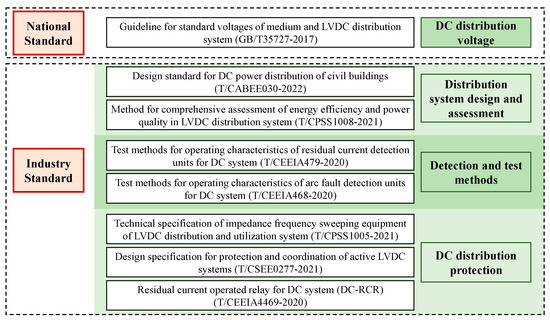
Figure 1.
New standards for LVDC technology in the past five years.
3. Engineering Application of LVDC Buildings in China
In fact, engineering projects which adopted this technology were implemented as early as ten years ago. We investigated 68 LVDC projects to summarize the development status and engineering application characteristics of this technology.
3.1. Category of LVDC Building Projects
Depending on the analysis of building types, the office and commercial building account for 50%; the residential building and the education building account for 19.1%, respectively; other engineering applications include hotels, parks, and the DC microgrid, etc. (Figure 2). On the whole, the LVDC projects focus on engineering demonstration applications and aim to enhance the local consumption of renewable energy and reduce building energy consumption and carbon emissions according to actual situations. Most office building projects are demonstrations carried out by power grid and building technology companies. One such project is the the DC building demonstration of the Future Complex of Shenzhen Institute of Building Research Co., Ltd. (Shenzhen, China) [11]. Solar PV and BES are integrated as renewable power sources while three voltage levels, i.e., 750 V, 375 V, and 48 V, are adopted to provide power for appliances with different power factors (Figure 3). Moreover, scientific districts and new rural construction also have LVDC demonstration projects—e. g. Xiong’an Future City Scientific and Technological Development Center project and Ruicheng New Energy Equipment Industrial Park—to explore new energy systems for the application of renewables. Some real estate companies also innovatively apply LVDC technology to commercial buildings, hoping to expose the technology to the market.
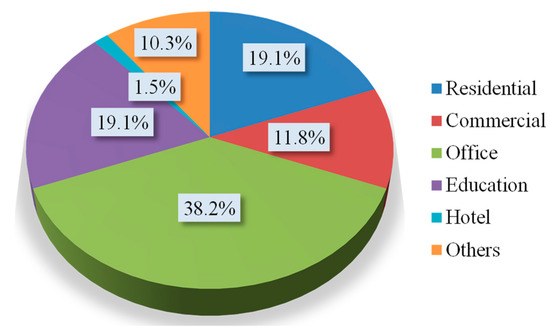
Figure 2.
Proportion of LVDC buildings in different categories.
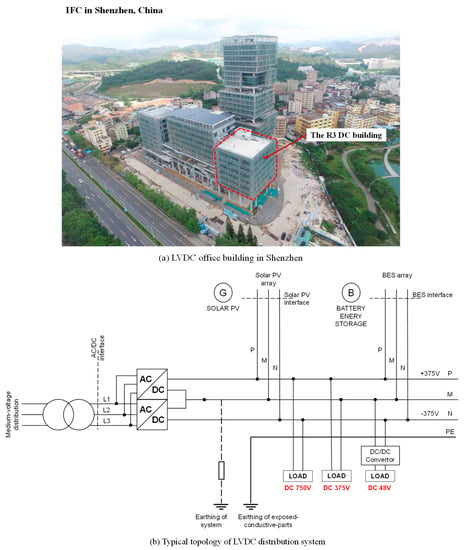
Figure 3.
Application of LVDC technology in a typical office building.
LVDC projects that concentrate on solar PV applications have been put into operation in residential buildings. The Suzhou Jiayuan Villa project is a DC distribution demonstration residence created early by the state grid, which has constructed a building DC microgrid that integrates BES systems and the integrated energy system of charging piles. A rural energy microgrid with a PV-installed capacity of 2 MW has been set up in Zhuangshang Village, Shanxi Province, serving as a typical residential LVDC demonstration project. Institutions of higher learning and some educational, scientific, cultural, and health venues open to the public also have demonstration projects. These projects are important to technical exploration and scientific research, which can verify the feasibility of different routes.
In terms of the geographical distribution, the LVDC projects are mainly distributed in economically developed regions such as the Pearl River Delta region, the Yangtze River Delta region, Beijing, and Shanghai. Among them, Guangdong Province ranks first in the number of projects (Figure 4). This is because the low-carbon development guidelines of the Guangdong–Hong Kong–Macao Greater Bay area have brought more supportive policies to the LVDC projects. Beijing and Jiangsu Province are also forerunners of the LVDC pilot projects, each having 10 projects, including the laboratory buildings for research and the technology pilot demonstration projects. Shanxi Province spearheads the application of LVDC technology in towns and villages, including seven projects. Notably, apart from economically developed regions, there are relevant cases in other provinces, such as Hubei, Jiangxi, and Guizhou. This indicates that as a major low-carbon development path, LVDC technology has received recognition and support from more local governments and has become one of the key energy application technologies to achieve future carbon peaking and carbon neutrality goals.

Figure 4.
Geographical distribution of LVDC buildings.
3.2. Main Technology Application in Projects
3.2.1. Solar PV
The main feature of LVDC buildings is the application of solar PV generation in buildings. Approximately 3~5% of the energy lost in conversion can be reduced because that LVDC system does not need an AC/DC converter in renewable access. Renewable generators can be integrated in an LVDC microgrid without too much consideration of impacts for grid stability. Hence, these projects follow the principle of maximizing the use of renewables—that is, installing solar PV panels on the available space, such as rooftops and facades of the buildings as much as possible. In terms of the project scale, there are 25 projects with a PV installed capacity of more than 100 kWp, accounting for 36.8% (Figure 5). Antuoshan Park of Huawei Digital Power Technology Co., Ltd. has a PV installed capacity of 2670 kWp, which is a MW level on-site PV project, with all PV panels installed on the rooftops and facades of buildings. It is worth mentioning that most projects with a PV installed capacity of more than 100 kWp connect to the power grid after generation, whereas projects with a PV installed capacity of less than 100 kWp use the power by themselves after generation. This is due to the mismatch between the load curve of the building and the PV generation. With economic factors taken into account, the projects with a larger PV capacity choose the operating strategy of grid connection.
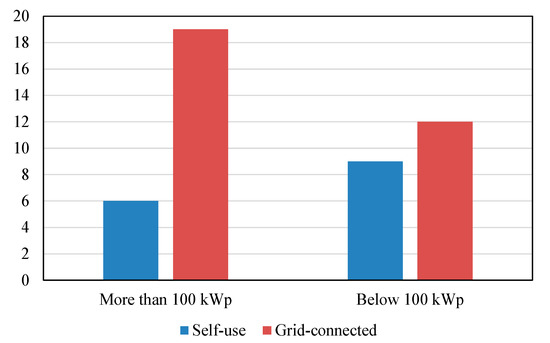
Figure 5.
Distribution of PV grid-connected projects.
3.2.2. Distributed Energy Storage
With the advancement of energy storage technology and over many years of verification of engineering applications, the application cases and technologies used for distributed energy storage have gradually increased [12,13]. In addition to thermal energy storage (TES), such as phase-change materials, water storage, and ice storage, electrochemical energy storage, represented by batteries, is also a commonly used solution for green buildings for energy conversation or increases to efficiency. Among all LVDC projects, more than 90% of the projects adopt demand-side energy storage, of which four projects use TES technology, and three projects concurrently use BES and TES as shown in Figure 6. The remaining 40 projects adopt BES. TES technology normally adopts the cool storage tank and air-conditioning refrigeration linkage pattern, which realizes cool storage by using the heat capacity at night in summer and release at peak periods of cooling [14]. The projects equipped with BES and TES technology have to address the optimization of energy distribution and the integrated control of the system, which are confronted with greater challenges in technology than other projects.
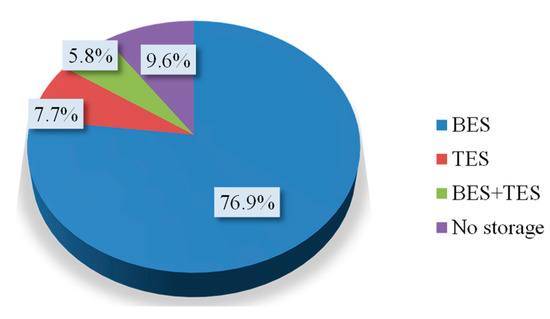
Figure 6.
Distribution of energy storage technologies used in the projects.
The battery types used in the electrochemical energy storage systems in these cases are distributed as shown in Figure 7. Approximately 3/4 of the projects use lithium iron phosphate batteries. This battery type possesses a clear advantage in the application of building energy storage. Featuring a long service life, high energy density, and good safety performance, LiFePO4 batteries are probably used more than any alternatives on a large scale in building energy storage. A total of 11.6% of the projects use lead–acid batteries. This battery is environmentally friendly and recoverable, enjoys high stability and security, and costs less than alternatives. However, lead–acid batteries will be phased out because its disadvantages, namely discharge rate and life cycle, which make the battery unable to meet the building energy storage requirements of high power and frequency. Sodium-ion batteries and lithium titanate batteries are also used. The safety precautions for electrochemical energy storage equipment are notable in actual LVDC projects. Additionally, the user-side energy storage environment should be kept controlled, and the risks of battery thermal runaway should be reduced along with reasonable battery management.
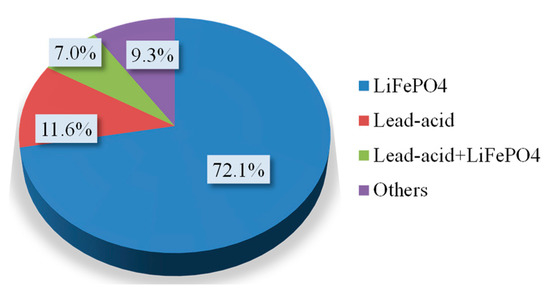
Figure 7.
Proportion of electrochemical energy storage technologies.
3.2.3. DC Distribution System Design
In terms of distribution mode, there are AC/DC hybrid distribution systems and global DC distribution systems. In terms of system topology, there are unipolar and bipolar structures [15]. The projects’ selection of distribution system structures is shown in Figure 8. A total of 35 projects chose to use the AC/DC hybrid distribution system, 2.5 times those which chose the DC distribution system (14 projects). The tendency to use the AC/DC hybrid distribution system is due to the DC distribution system being less mature than the AC distribution system now. At present, AC distribution is still necessary for some scenarios and electrical appliance applications, so the applicability of the AC/DC hybrid distribution system is higher than that of the DC distribution system. As for the selection of topology, the bipolar structure can get access to electric equipment with different powers (e.g., 750 V for air conditioner and 375 V for water heater) because it has more voltage classes than the unipolar structure, so it is more suitable for the full DC distribution system. However, as the bipolar structure has a more complex system and requires more difficult conservation and energy management technologies, unipolar structures are recommended in actual engineering. Most digital appliances, like mobile phones and PCs, use DC power directly. DC-driven LED lighting and air conditioners can be found on the market whereas GREE and Midea, famous electrical appliance manufacturers in China, are developing DC products. However, a clear distinction can be found in the LVDC system in application. For example, a DC system plug is different from that of the AC system, so users should be trained how to use such plugs. Protection technologies of DC are different so that new equipment such as breakers, residual-current devices (RCD), arc fault detection devices (AFDD), and insulation-monitoring devices (IMD), et al., with different functions should be developed.
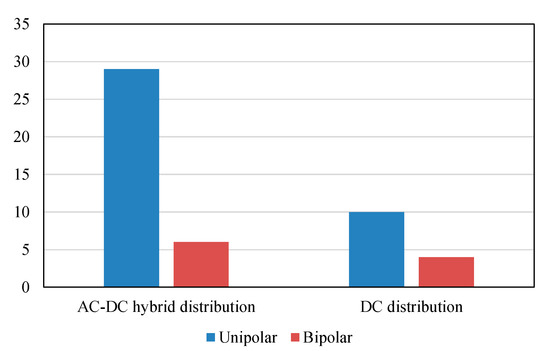
Figure 8.
Selection of power distribution system.
The voltage of the DC bus is another key element in the design of the power distribution system [16]. The following voltages are selected in these cases: 750 V, 400/375 V, 220 V, and 48 V, which are used for (1) high-power electrical appliances with a power of 5 kW or above; (2) electrical appliances with a power of 500 W to 5 kW; and (3) low-power electrical appliances with a power of 500 W or below. Application scenarios are always considered when choosing the voltage. For example, 750 V and 220 V are often used for power distribution in park and residence projects because the commercially available electrical equipment for municipal administration and domestic use can get access to 220 V DC. Voltages of 750 V and 400/375 V are often used for office and commercial buildings to reduce the current and cable loss and increase the electricity usage efficiency. As 48 V is safer and can meet the power use and supply demands for LED lighting and desktop devices, the projects involving low-power electricity consumption (with a power of less than 1000 W) choose this voltage.
3.2.4. Energy Flexibility Technology
Due to the simplicity of the DC voltage droop control method, more than 50% of the projects (35 projects) realize the flexibility energy management over the energy consumption of the buildings through the active power regulation technology based on the bus voltage droop control method [17,18]. A total of 20% of the projects adopt power control solutions, including ice storage and the ordered charge and discharge of electric vehicles, which can be used as removable energy storage and energy router technology.
A typical DC voltage droop control method is shown as Figure 9a, the DC rated voltage is set to 375 V and fluctuates between 319 V (85% of rated voltage) and 394 V (105% of rated voltage) without affecting the use of electrical appliances. If the voltage continues to rise to 400 V, or drop to 300 V, it will reach a hysteresis zone where appliances can still work. Only when these two limits are exceeded, under-voltage and over-voltage protection will be triggered. Therefore, the DC power distribution control can regulate the system energy based on the characteristics of a wide, working voltage band and a converter’s voltage droop curve. Figure 9b shows the voltage droop control curve of a typical bi-directional DC/DC converter which outputs power varies with bus voltage. When the bus voltage is lower than UL, the converter operates with maximum output power Pmax. The converter’s output power Pref will decrease as the voltage increases to UBES. Then, the converter turns to charge with increasing power and reaches to maximum (Pmax) when voltage rises to UH.
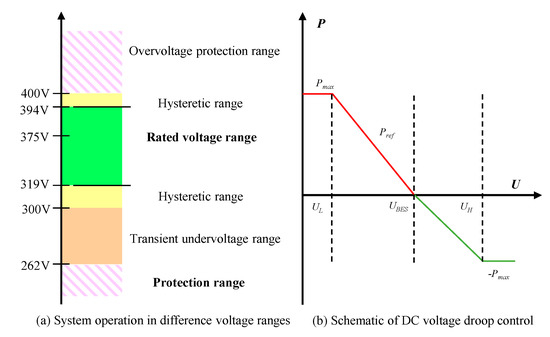
Figure 9.
The control principle of DC distribution system.
The system control logic adopted in an LVDC microgrid is shown in Figure 10, which shows the output power relationship of the utility grid, BES, and PV at different bus voltages. When voltage is below 415 V, PV will begin to generate electricity and increase the power as voltage drops until it reaches the maximum output at 390 V. At this time, BES charges with constant power. When voltage is between 390 V and 375 V, BES charge power will begin to decrease as voltage drops, and will reach 0 when voltage reduces to 380 V. Then, BES turns to discharge and rises to maximum power at 375 V. When voltage drops to 375 V, the grid turns to output and reaches maximum power when the voltage reaches 315 V. According to the above logic, different energy management strategies can be implemented by adjusting the bus voltage and voltage droop curves of converters. Compared with the AC system, the LVDC system adopts the voltage droop control method for energy management, which is simpler, more efficient, and proven for engineering applications. This building energy system is able to import more demand-side renewable energy resources and provide reliable and efficient energy management technology. LVDC buildings change the amount of imported electricity from the utility grid by managing renewable energy generation, which enhances the energy flexibility of the utility grid [19].
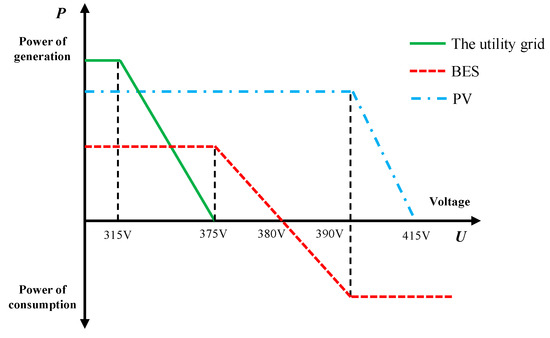
Figure 10.
DC voltage droop control in LVDC building.
4. The Attitude of Engineering Stakeholders
The application of LVDC technology not only involves the building and power sectors but also relates to energy, environment protection, and transportation. We investigated the stakeholders of all projects, including of academic institutions, consulting and design agencies, equipment manufacturers, government agencies, and engineering companies. The investigation focuses on the motivation for implementing the technologies, main barriers, and desired support, with the hope of determining future development directions.
4.1. Motivation for LVDC Building Construction
4.1.1. Driving Forces
Policies and economic efficiency are the driving forces for developing new engineering technologies. As shown in Table 2, approximately 75% of the interviewees considered that the LVDC projects aimed to provide demonstrations for scientific research and respond to calls of the state. Meanwhile, the projects can be integrated into a business model of comprehensive energy services and create new opportunities for profits. From the perspective of the technology itself, LVDC distribution can enhance the power supply reliability and power quality and reduce the power cost to a certain degree (in specific application scenarios). Architectural practitioners hold the opinion that technology has discovered opportunities for industrial development. From the perspective of distributed energy application, DC distribution is more economical and can enhance the grid capability while increasing the PV generation earnings.

Table 2.
Driving forces for developing LVDC technology.
4.1.2. Values and Benefits
In addition to relevant policies and industrial development, the industry also hopes to tap more technical values in the LVDC buildings as shown in Table 3. The local consumption technology of renewable energy reduces the difficulty brought by the wind–solar–electricity-connected grid as well and the investment cost for the power supply companies, and this measure tallies with the technical demonstration of new power systems, which represents the most potential value in this technology. Moreover, the SELV DC power supply mode brings a better electrical safety experience to civil buildings and achieves off-grid operation. Equipment suppliers consider the new technology as a marketing tool, and use LVDC technology as a promotion focus to attract more potential customers.

Table 3.
Values created by LVDC buildings.
4.2. Technical Barriers
To take the right countermeasures, except the technical driving forces, engineering investors must learn about the barriers and deficiencies in technology. As shown in Table 4, the barriers to the promotion of LVDC buildings come from the following aspects: specification, products, safety, motivating measures, and operation and maintenance measures. The biggest problem that the current engineering applications face is the lack of design and product standards. The issue of the design standard for LVDC power distribution of civil buildings can solve some of the above problems to a certain extent; however, there are still many construction methods that are in urgent need of being guided by the specifications. The second problem is the lack of products, such as DC devices, electrical products, and special converters. Due to the difficulty of production, these products are expensive and the suppliers are also limited. Moreover, the renovation of the power distribution system and the application of distributed energy storage in the existing buildings are involved in the LVDC projects, which are extremely innovative and can bring safety issues which should not be ignored. New DC distribution technologies and essential production lines must be developed instantly. In terms of financial incentives, insufficient subsidy policies make the investors in both power companies and non-power grid companies unmotivated for project implementation. In terms of operation and maintenance management, technical professionals are needed for the building of DC distribution systems, so the training of talent in this field is also a future work of technology development.

Table 4.
Technical barriers to the promotion of LVDC buildings.
4.3. Recommended Policy Guiding
According to the analysis of the motivations and the technical barriers, we summarize the possible policy directions and necessary patterns and mechanisms for developing LVDC buildings as shown in Table 5.

Table 5.
Policy guiding which contributes to technology development.
Issuing specifications and policies: The standard system of the LVDC buildings should be completed, and the practical issues in the project implementation should be solved first (e.g., construction methods, PV installation requirements for buildings, and safety standards for BES of buildings).
Strengthen market vitality: Based on the development of new power system technologies, the purpose of LVDC buildings is to participate in grid demand response and participate in the electric auxiliary service market. Appropriate price mechanisms should be implemented to return the benefits brought by building PV consumption and grid peak regulation, so that more users can benefit from the technology.
Preferential economic policies: This includes a focus on overcoming technical problems and support high-tech enterprises with independent brands. One must incorporate relevant policies into the promotion system of clean heating policies as soon as possible to double the benefits. Taking advantage of the low building density in rural areas, a rural LVDC separation policy is introduced to achieve a win–win situation for PV generation and grid connection.
5. Conclusions
Under the national development goal of carbon peaking and carbon neutrality, reform of the building energy system, which imports more renewable energy resources and uses smart control, has been developed and adopted in China currently. LVDC buildings, which are different from traditional buildings using alternating current power, adopt a DC distribution system and integrate renewable energy generation and distributed energy storage. This technology is proved to have advantage to access the distributed generation with solar PV and BES, and application of electric vehicles as new energy consumers. DC distribution systems can effectively reduce energy loss in conversion, improve energy control efficiency, and provide more security and reliability for building microgrid energy consumption. The application of LVDC technology not only reduces carbon emissions during buildings’ operation, but also improves energy reliability and smart control effects.
This study investigated the relevant policies and standards which support development of LVDC building industries in China. A project survey of more than 60 practical LVDC buildings was conducted, and the status of technology application was analyzed. The attitude of engineering stakeholders in LVDC projects was discussed and advantages as well as drawbacks of LVDC buildings development were listed. With regard to policies which benefit the development of LVDC buildings, the Chinese government announced authoritative policies to implement the application of grid demand response and solar PV, beginning in 2020. The improvement of energy market trading mechanisms accelerates the increase of energy flexibility of end users. These positive policies enhance the investigation and construction of LVDC buildings, so that national and industry standards, which involve LVDC technology such as voltage, system design and assessment, testing method, protection, were developed. Among LVDC buildings in China, it can be seen that office and commercial buildings account for 50% of the engineering application, which means those two types building are more suitable to adopt LVDC technologies. From the view of distributed energy resources, solar PV and BES experiences an increasing application in buildings while security issues are solved step by step. An AC/DC hybrid distribution system seems to be more convenient and stable than DC distribution system in recent stage. The voltage droop control method, which makes energy management in the LVDC system easier, is adopted in many projects to realize energy flexibility. Finally, we investigated the stakeholders of all projects, including designers, estate developers, and owners, and summarized the benefits and barriers of LVDC buildings. The lack of design and product standards, and corresponding DC appliances are the main drawbacks raised by most stakeholders. Completing awarding mechanisms of grid demand response and encouraging LVDC buildings to participate in the utility grid regulation are two practical guiding policies which can improve the benefits and usage for LVDC projects. Future work on LVDC building development in China will focus on the ability to meet the corresponding technical standards and to develop low-cost products of DC power distribution.
Author Contributions
Conceptualization, B.H.; Data curation, H.L.; Formal analysis, J.K.; Investigation, J.K. and H.L.; Project administration, Y.L. and Z.X.; Software, Z.X.; Supervision, B.H.; Writing–original draft, J.K.; Writing–review & editing, Y.L. All authors have read and agreed to the published version of the manuscript.
Funding
This research was funded by Energy Foundation grant number PRSKYKT20210004GD.
Informed Consent Statement
Not applicable.
Conflicts of Interest
The authors declare no conflict of interest.
References
- Wei, Y.M.; Chen, K.; Kang, J.N.; Chen, W.; Wang, X.Y.; Zhang, X. Policy and management of carbon peaking and carbon neutrality: A literature review. Engineering 2022, 14, 52–63. [Google Scholar] [CrossRef]
- Glasgo, B.; Azevedo, I.L.; Hendrickson, C. How much electricity can we save by using direct current circuits in homes? Understanding the potential for electricity savings and assessing feasibility of a transition towards DC powered buildings. Appl. Energy 2016, 180, 66–75. [Google Scholar] [CrossRef]
- Dastgeer, F.; Gelani, H.E.; Anees, H.M.; Paracha, Z.J.; Kalam, A. Analyses of efficiency/energy-savings of DC power distribution systems/microgrids: Past, present and future. Int. J. Electr. Power Energy Syst. 2019, 104, 89–100. [Google Scholar] [CrossRef]
- Gerber, D.L.; Vossos, V.; Feng, W.; Marnay, C.; Nordman, B.; Brown, R. A simulation-based efficiency comparison of AC and DC power distribution networks in commercial buildings. Appl. Energy 2017, 210, 1167–1187. [Google Scholar] [CrossRef]
- Chacko, R.; Thevarkunnel, A.; Lakaparampil, Z.; Thomas, J. DC nanogrid for Buildings: Study based on experimental investigation of load performance and Annual energy consumption. Mater. Today Proc. 2022, 58, 352–358. [Google Scholar] [CrossRef]
- Hallemans, L.; Ravyts, S.; Govaerts, G.; Fekriasl, S.; Van Tichelen, P.; Driesen, J. A stepwise methodology for the design and evaluation of protection strategies in LVDC microgrids. Appl. Energy 2022, 310, 118420. [Google Scholar] [CrossRef]
- Prakash, R.; Basavayya, V.; Pandian, A.; Muni, T.V. Energy management system for DC microgrids. Mater. Today Proc. 2022. [Google Scholar] [CrossRef]
- Duan, J.; Li, Z.; Zhou, Y.; Wei, Z. Study on the voltage level sequence of future urban DC distribution network in China: A Review. Int. J. Electr. Power Energy Syst. 2020, 117, 105640. [Google Scholar] [CrossRef]
- Zhang, N.; Yang, D.; Zhang, H.; Luo, Y. Distributed control strategy of DC microgrid based on consistency theory. Energy Rep. 2022, 8, 739–750. [Google Scholar] [CrossRef]
- Fan, Y.; Chi, Y.; Li, Y.; Wang, Z.; Liu, H.; Liu, W.; Li, X. Key technologies for medium and low voltage DC distribution system. Glob. Energy Interconnect. 2021, 4, 91–103. [Google Scholar] [CrossRef]
- Kang, J.; Hao, B.; Li, Y.; Lu, Y.; Li, Y. Practice of DC Distribution System-based Building Microgrid: A Case of IBR. In Proceedings of the 12nd International Symposium on Heating, Ventilation and Air Conditioning (ISHVAC 2021), Seoul, Korea, 24–26 November 2021. [Google Scholar]
- Novoa, L.; Flores, R.; Brouwer, J. Optimal renewable generation and battery storage sizing and siting considering local transformer limits. Appl. Energy 2019, 256, 113926. [Google Scholar] [CrossRef]
- Georgakarakos, A.D.; Vand, B.; Hathway, E.A.; Mayfield, M. Dispatch Strategies for the Utilisation of Battery Storage Systems in Smart Grid Optimised Buildings. Buildings 2021, 11, 433. [Google Scholar] [CrossRef]
- Tang, R.; Wang, S. Model predictive control for thermal energy storage and thermal comfort optimization of building demand response in smart grids. Appl. Energy 2019, 242, 873–882. [Google Scholar] [CrossRef]
- Gwon, G.-H.; Kim, C.-H.; Oh, Y.-S.; Noh, C.-H.; Jung, T.-H.; Han, J. Mitigation of voltage unbalance by using static load transfer switch in bipolar low voltage DC distribution system. Int. J. Electr. Power Energy Syst. 2017, 90, 158–167. [Google Scholar] [CrossRef]
- Siraj, K.; Khan, H.A. DC distribution for residential power networks—A framework to analyze the impact of voltage levels on energy efficiency. Energy Rep. 2020, 6, 944–951. [Google Scholar] [CrossRef]
- Xiao, Q.; Mu, Y.; Jia, H.; Jin, Y.; Hou, K.; Yu, X.; Teodorescu, R.; Guerrero, J.M. Modular multilevel converter based multi-terminal hybrid AC/DC microgrid with improved energy control method. Appl. Energy 2020, 282, 116154. [Google Scholar] [CrossRef]
- Sayed, S.S.; Massoud, A.M. A generalized approach for design of contingency versatile DC voltage droop control in multi-terminal HVDC networks. Int. J. Electr. Power Energy Syst. 2020, 126, 106413. [Google Scholar] [CrossRef]
- Hafsi, O.; Abdelkhalek, O.; Mekhilef, S.; Soumeur, M.A.; Hartani, M.A.; Chakar, A. Integration of hydrogen technology and energy management comparison for DC-Microgrid including renewable energies and energy storage system. Sustain. Energy Technol. Assess. 2022, 52, 102121. [Google Scholar] [CrossRef]
Publisher’s Note: MDPI stays neutral with regard to jurisdictional claims in published maps and institutional affiliations. |
© 2022 by the authors. Licensee MDPI, Basel, Switzerland. This article is an open access article distributed under the terms and conditions of the Creative Commons Attribution (CC BY) license (https://creativecommons.org/licenses/by/4.0/).
























